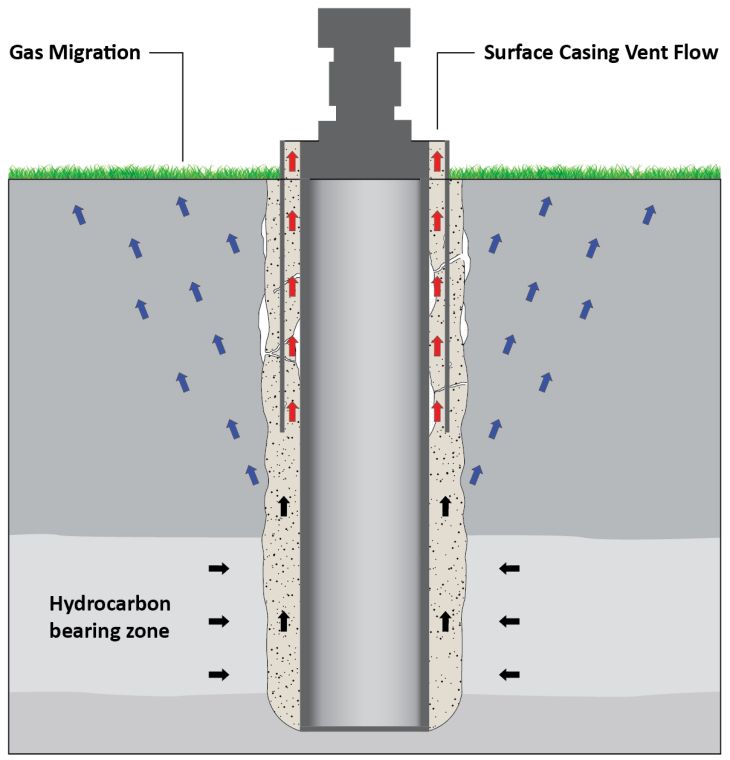Well emissions are the release of gases (primarily methane) from oil and gas wells. Surface casing vent flow (SCVF) and gas migration (GM) are types of well emissions that can occur at some oil or gas wells due to imperfections with well seals, which may result from drilling or cementing conditions, failure of downhole components or from methods practiced at older wells not constructed to present-day standards. Surface casing vent flow involves the movement of well gases upwards through the space between the surface casing and the next innermost casing (represented by the red arrows in image below), whereas gas migration is the movement of gas outside of the surface casing of the well (blue arrows in the image below).

Reducing gas emissions, including emissions from wells, is a priority for the BCER. We maintain a robust regulatory regime concerning well emissions, including testing and reporting requirements, as specified by the Drilling and Production Regulation (DPR).
Surface Casing Vent Flows
Testing for the presence of a surface casing vent flow is required at different times throughout the life cycle of a well. The BCER maintains a database of Surface Casing Vent Flow (SCVF) submissions from industry. The figures below use the latest data from this SCVF database to produce an approximate snapshot of the current state of SCVF in the province among wells for which permit holders have made submissions.
Figure 1. Distribution of surface casing vent flow rates among non-decommissioned wells in B.C. with an identified SCVF
Non-decommissioned wells are those wells that have not been permanently plugged and cut/capped. See our Restoring Oil & Gas Sites page for more information on the life-cycle of a well.
While operators are required to report a SCVF, there is currently no regulatory requirement to submit subsequent reports to the BCER. As a result, it is possible the characteristics of a SCVF have changed, or it has been repaired since the initial report and the permit holder would not be required, under the Drilling and Production Regulation, to make such a report. However, permit holders are encouraged to make, and in many cases have made, multiple submissions throughout the life of the well, to ensure the BCER has current information on the state of SCVF emissions in the province. Only the most recent report from any given well is included in Figure 1.
This graph excludes reports with SCVF rates greater than 100 m3/day because Section 52.11 of the Drilling and Production Regulation prohibits SCVF emissions over 100 m3/day. In cases where SCVF emissions exceed 100 m3/day, operators are required to act to bring the emissions below 100 m3/day. At time of writing, all known wells with a SCVF greater than 100 m3/d had been repaired or otherwise prevented from emitting to the atmosphere.
Gas Migration
Gas migration at a well can be spatially and temporally variable, making it challenging to observe, and identify during inspections. A permit holder must immediately notify the BCER when GM is discovered, and conduct and submit a risk assessment without delay.
The BCER maintains a database of gas migration submissions from industry since 2010. This database includes records for all wells where submissions have been made regardless of whether the wells are currently active, inactive or decommissioned and, where applicable, pre- and post-repair test results. Instances of gas migrations are assessed as either "non-serious" or “serious," the latter indicating an immediate safety hazard or potential for environmental damage.
Figure 2. Number of wells with reported gas migration in B.C. by gas migration severity